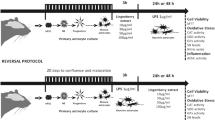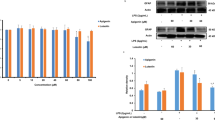Abstract
Cyanidin and chlorogenic acid are polyphenols from plant origin that are present in many common fruits, particularly in berries. To corroborate the protective or detrimental effects of both compounds from a neuro-inflammatory perspective, in vitro experiments were carried out in human astrocytes (U-373). Astrocytes were pre-treated with a range of concentrations of either cyanidin, chlorogenic acid or a combined treatment for a period of 30 min, before exposure to Escherichia coli lipopolysaccharide (LPS) challenge for 23.5 h, after which cytotoxicity (propidium iodide exclusion assay), cytoprotective effects (XTT assay) and effects on functional capacity (secretion of pro-inflammatory cytokines IL-6 and MCP-1) were evaluated. No treatment resulted in cytotoxicity, but high dose (20 µg/mL) LPS significantly reduced mitochondrial reductive capacity (p < 0.001). This effect was prevented in a dose-dependent manner by both cyanidin and chlorogenic acid, as well as by the combination treatment. However, in the absence of LPS, IL-6 secretion was significantly increased in response to 2 µM of either cyanidin or chlorogenic acid (both p < 0.0001), as well as the combination treatment (p < 0.01). MCP-1 secretion followed a similar trend, but did not reach statistical significance. Although we acknowledge the requirement for in vivo investigations to validate our interpretations, current data highlight the potential risk for antioxidant toxicity that is linked to high dose supplementation with single compound antioxidants. Research focused at elucidating synergistic effects between different antioxidants is required to minimise risk of adverse effects.




Similar content being viewed by others
References
Ames BN, Shigenaga MK, Gold LS (1993) DNA lesions, inducible DNA repair, and cell division: three key factors in mutagenesis and carcinogenesis. Environ Health Perspect 101 (Suppl 5):35–44
Amorini AM, Fazzina G, Lazzarino G, Tavazzi B, Di Pierro D, Santucci R, Sinibaldi F, Galvano F, Galvano G (2001) Acitivity and mechanisms of the antioxidant properties of cyanidin-3-O-beta-glucopyranoside. Free Radic Res 35(6):953–966
Baker B, Maitra U, Geng S, Li L (2014) Molecular and cellular mechanisms responsible for cellular stress and low-grade inflammation induced by a super-low dose of endotoxin. J Biol Chem 289(23):16262–16269. https://doi.org/10.1074/jbc.M114.569210
Balkwill FR, Burke F (1989) The cytokine network. Immunol Today 10:299–304. https://doi.org/10.1016/0167-5699(89)90085-6
Barres BA (2008) The mystery and magic of glia: a perspective on their roles in health and disease. Neuron 60:430–440
Bennett AC, Van Camp A, Lopez V, Smith C (2018) Sceletium tortuosum may delay chronic disease progression via alkaloid-dependant antioxidant or anti-inflammatory action. J Physiol Biochem. https://doi.org/10.1007/s13105-018-0620-6
Bolin LM, Zhaung A, Strychkarska-Orczyk I, Nelson E, Huang I, Nguyen MQ (2005) Differential inflammatory activation of IL-6 (−/−) astrocytes. Cytokine 30(2):47–55
Bowry VW, Stocker R (1993) Tocopherol-mediated peroxidation: the pro-oxidation effect of vitamin E on the radical-initiated oxidation of human low-density lipoprotein. J Am Chem Soc 115:6029–6044
Cásedas G, González-Burgos E, Smith C, López V, Gómez-Serranillos MP (2018) Regulation of redox status in neuronal SH-SY5Y cells by blueberry (Vaccinium myrtillus L.) juice, cranberry (Vaccinium macrocarpon A.) juice and cyanidin. Food Chem Toxicol 118:572–580
Colliou E, Mari A, Delas A, Delarche A, Faguer S (2017) Oxalate nephropathy following vitamin C intake within intensive care unit. Clin Nephrol 88(12):354–358
De Felice FG, Farreira ST (2014) Inflammation, defective insulin signalling, and mitochondrial dysfunction as common molecular denominators connecting type 2 diabetes to Alzheimer disease. Diabetes 63(7):2262–2272. https://doi.org/10.2337/db13-1954
Galaris D, Evangelou A (2002) The role of oxidative stress in mechanisms of metal-induced carcinogenesis. Crit Rev Oncol Hematol 42(1):93–103
Ghosh D (2015) Nutrition’s growing role in fighting inflammation. Neutraceuticals World, 1. http://www.nutraceuticalsworld.com/issues/2015-2001/view_features/ nutritions-growing-role-in-fighting-inflammation
Hart C, Cohen R, Norwood M, Stebbing J (2012) The emerging harm of antioxidants in carcinogenesis. Future Oncol 8:535–548
Hernandez MR, Miao H, Lukas T (2008) Astrocytes in glaucomatous optic neuropathy. Prog Brain Res 173:353–373
Hwang SJ, Kim Y, Park Y, Lee H, Kim K (2014) Anti-inflammatory effects of chlorogenic acid in lipopolysaccharide-stimulated RAW 264.7 cells. Inflamm Res 63:81–90
Jones DP, Mody VC Jr, Carlson JL et al (2002) Redox analysis of human plasma allows separation of pro-oxidant events of aging from decline in antioxidant defenses. Free Radic Biol Med 33(9):1290–1300
Jun T, Liancai Z, Bochu W (2007) Effects of quercetin on DNA damage induced by copper ion. Int J Pharmacol 3(1):19–26
Karve IP, Taylor JM, Crack PJ (2016) The contribution of astrocytes and microglia to traumatic brain injury. Br J Pharmacol 173(4):692–702
Kaushal V, Dye R, Pakavathkumar P, Foveau B, Flores J, Hyman B, Ghetti B, Koller BH, LeBlanc AC (2015) Neuronal NLRP1 inflammasome activation of Caspase-1 coordinately regulates inflammatory interleukin-1-beta production and axonal degeneration-associated Caspase-6 activation. Cell Death Differ 22:1676–1686. https://doi.org/10.1038/cdd.2015.16
Khakimov B, Engelsen SB (2017) Resveratrol in the foodomics era: 1:25,000. Ann N Y Acad Sci 1403(1):48–58
Kim TJ, Buyn JS, Kwn HS, Kim DY (2018) Cellular toxicity driven by high-dose vitamin C on normal and cancer stem cells. Biochem Biophys Res Comm 497(1):347–353
Kodali M, Hattiangady B, Shetty GA, Bates A, Shuai B, Shetty AK (2018) Curcumin treatment leads to better cognitive and mood function in a model of Gulf War Illness with enhanced neurogenesis, and alleviation of inflammation and mitochondrial dysfunction in the hippocampus. Brain Behav Immun 69:499–514
Lee B, Lee DG (2018) Depletion of reactive oxygen species induced by chlorogenic acid triggers apoptosis-like death in Escherichia coli. Free Radic Res 52(5):605–615
Li N, Zhang X, Dong H, Zhang S, Sun J, Qian Y (2016) Litium amerliorates LPS-induced astrocyte activation partly via inhibition of toll-like receptor 4 expression. Cell Physiol Biochem 38:714–725
Liu Z (2014) Antioxidants may not always be beneficial to health. Nutrition 30:131–133
MacNee W, Rabinovich RA, Choudhury G (2014) Ageing and the border between health and disease. Eur Respir Soc 44:1055–1068
Miller ER III, Guallar E (2009) Vitamin E supplementation: what’s the harm in that? Clin Trials 6:47–49
Nimse SB, Pal D (2015) Free radicals, natural antioxidants and their reactions mechanisms. RSC Adv 5:27986. https://doi.org/10.1039/c4ra13315c
Olivo L (2016) Insights on antioxidants: keys to future development. Neutraceuticals World, 3. www.nutraceuticalsworld.com/issues/2016-2003/view_features/insights-on-antioxidants-keys-to-future-development
Parpura V, Heneka MT, Montana V, Oliet SH, Schousboe A et al (2012) Glial cells in (patho)physiology. J Neurochem 121:4–27
Petersen KS, Smith C (2016) Ageing-associated oxidative stress and inflammation are alleviated by products from grapes. Oxidative Medicine and Cellular Longevity (Special issue: Medicinal Plants in Therapy: antioxidant activities) 2016:4. https://doi.org/10.1155/2016/6236309
Smith C (2011) The effects of Sceletium tortuosum in an in vivo model of psychological stress. J Ethnopharmacol 133:31–36
Smith C (2018) Natural antioxidants in prevention of accelerated ageing: a departure from conventional paradigms required. J Physiol Biochem. https://doi.org/10.1007/s13105-018-0621-5
Tarassisshin L, Suh HS, Lee SC (2014) LPS and IL-1 differentially activate mouse and human astrocytes: role of CD14. Glia 62(6):999–1013
Tobwala S, Fan W, Hines CJ, Folk WR (2014) Antioxidant potential of Sutherlandia frutescens and its protective effects against oxidative stress in various cell cultures. BMC Complement Altern Med 14:271 http://www.biomedcentral.com/1472-6882/14/271
Verpoorte R, Choi YH, Kim HK (2005) Ethnopharmacology and systems biology: a perfect holistic match. J Ethnopharmacol 100(12):53–56
WHO (2015) WHO Fact sheet. http://www.who.int. Accessed 15 Oct 2015
Winter AN, Ross EK, Khatter S, Miller K, Linseman DA (2017) Chemical basis for he disparate neuroprotective effects of the anthocyanins, callistephin and kuromanin, against nitrosative stress. Free Rad Biol Med 103:23–34
Zhang H, Zhang Y (2014) Melatonin: a well-documented antioxidant with conditional pro-oxidant actions. J Pineal Res 57:131–146
Acknowledgements
The South African National Research Foundation (NRF) is acknowledged for financial support.
Author information
Authors and Affiliations
Corresponding author
Ethics declarations
Conflict of interest
The authors declare no conflict of interest.
Rights and permissions
About this article
Cite this article
Cásedas, G., Bennett, A.C., González-Burgos, E. et al. Polyphenol-associated oxidative stress and inflammation in a model of LPS-induced inflammation in glial cells: do we know enough for responsible compounding?. Inflammopharmacol 27, 189–197 (2019). https://doi.org/10.1007/s10787-018-0549-y
Received:
Accepted:
Published:
Issue Date:
DOI: https://doi.org/10.1007/s10787-018-0549-y




